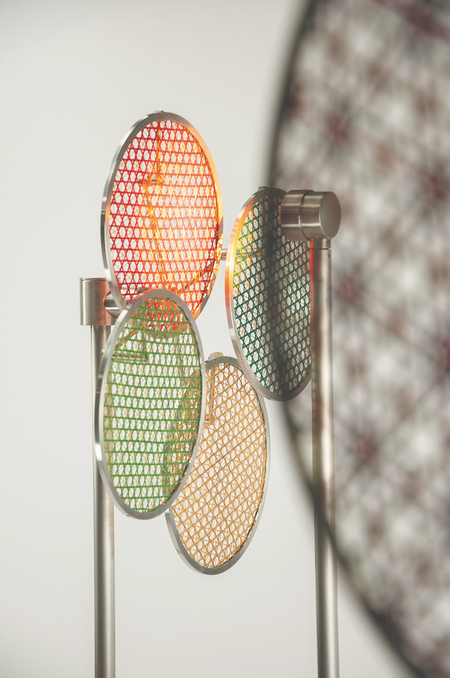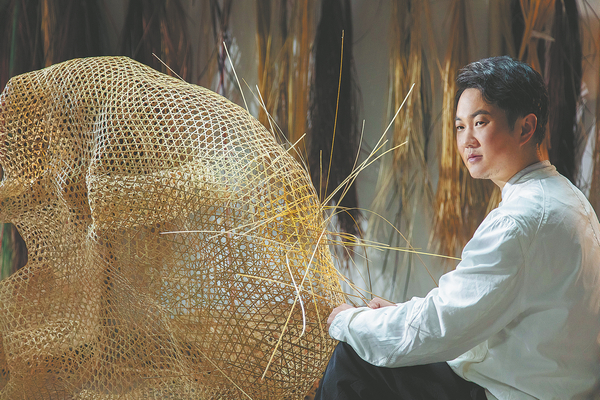Weaving the Wonder of Bamboo

Qian Lihuai's bamboo weaving Inception.CHINA DAILY
Qian Lihuai and Joint Lab twist tradition to craft concoctions that delight visitors and institutions alike, Li Yingxue reports.
In the China Pavilion at the sixth China International Import Expo in Shanghai, a piece of bamboo art resembling a Taihu Lake Stone was the center of attention.
It perfectly combined traditional craftwork with natural art, and demonstrated the beauty of the "thinness, perforations, convolutions and transparency" of the stone after which it was modeled.
What impressed the visitors most was that the "stone" was actually made entirely from bamboo.
It was the work of Qian Lihuai, an inheritor of traditional bamboo weaving techniques, a form of intangible cultural heritage from Zhejiang province.
Qian spent two months on the Taihu Lake piece. With no preexisting example to model it on, he had to start from scratch.
Following tradition while still innovating, and demonstrating the evolution of this traditional art, infusing it with fresh vitality, Qian has won a number of awards, and his works have been widely collected through exhibitions at home and abroad.
Rarely has anyone elevated the weaving of bamboo to such an art form, but Qian sees in the material boundless possibilities for artistic expression.
"I've always thought of bamboo weaving as a kind of brush to illustrate the world," he explains, adding that he has studied calligraphy and painting from an early age.

Another example of his work The Taihu Lake Stone exhibited at the China Pavilion at the sixth China International Import Expo.CHINA DAILY
Born in Wuzhen in Zhejiang, the 38-year-old has a unique bond with bamboo and whether it's in the form of indoor bamboo bonsai or backyard bamboo groves, the material is an essential element in his home.
Qian grew up in the village known for its bamboo weaving and after studying industrial design at the Zhejiang University of Science and Technology, he began to develop an interest in the technique, learning how to do it himself.
He also traveled widely in Hunan, Hubei, Sichuan and Yunnan provinces to learn local bamboo weaving techniques.
"The variations are quite substantial across the regions, and bamboo weaving comes in a wide array of forms. It's sometimes used to make agricultural tools, sometimes to make daily necessities, and sometimes for artistic purposes," Qian says.
"In Wuzhen, each locality focuses on producing a specific item. For instance our village's specialty is in making bamboo trays exclusively for rearing silkworms."
During a visit to a traditional basket maker in Shengzhou, Zhejiang, Qian saw that instead of using nails to fasten the basket together, the craftsman used a slanting cut on the bamboo to create a precise fit that rendered the joint virtually imperceptible.
"I rarely encounter such a level of craftsmanship. He even creates small molds and modifies tools himself to refine the weaving process," Qian says.
During his visits, he was moved by the dedication of the weavers to their craft. These experiences inspired him to return to his hometown of Wuzhen and throw himself into the bamboo weaving industry in 2013.
At first, Qian devoted a substantial amount of time to streamlining the production process, meticulously standardizing this handmade craft.

Bamboo-inspired lighting fixtures.CHINA DAILY
"Bamboo weaving lacks documented records, the skills have always been passed down orally. I spent a considerable period interviewing seasoned artisans and meticulously compiling records of weaving techniques," Qian explains.
After around six months, he made four woven bamboo boxes, one of which was acquired by Ma Weidu, a well-known connoisseur of art. This sale brought Qian recognition and generated many new orders.
After understanding the foundational logic of bamboo weaving and the patterns, and unwilling to duplicate his efforts, Qian began to add artistic touches to his bamboo weaving endeavors.
"My artistic innovation revolves around how weaving can convey the essence of the world. For instance, we employ a diverse range of colors to amplify its expressive potential, infusing bamboo weaving with a compelling language."
Many of the pigments Qian uses in his work are extracted from plants, deepening the environmental awareness of bamboo weaving.
Additionally, there is a dynamic connection and dialogue with other materials. "Bamboo's unique combination of rigidity and flexibility, distinct from many other materials like metals or textiles, positions it in an intermediary zone. I believe it serves as an excellent adhesive with other materials," Qian explains.
Bamboo techniques he has developed or improved are now widely used in everything from home furnishings to clothing, part of a growing trend toward replacing the use of plastic with bamboo, that demonstrates a continuity of the traditional Chinese culture in which bamboo has long been cherished as a topic for arts and a material for daily utensils.
He has also taught his bamboo weaving techniques at his alma mater, the Zhejiang University of Science and Technology, and says the course is not just about achieving a certain level of proficiency in bamboo weaving, but is designed to encourage open-minded thinking, exploring the ways of integrating bamboo weaving expertise into different fields.

Qian shows his artistry. CHINA DAILY
Joint Ideas
Besides his Taihu Lake Stone installation, Qian also displayed 12 woven bamboo patterns in unique shapes and colors that attracted attention at the expo.
He says that many visitors to the CIIE do not possess an in-depth understanding of bamboo weaving, and that most were more interested in its beauty. "The way we weave bamboo can capture and express this beauty, which is why it resonates with audiences, and is appreciated by them."
The Joint Laboratory of Digital Cultural Trade, a cultural trade platform, was responsible for introducing Qian's work to the China Pavilion at the CIIE, and the work was displayed alongside that of another inheritor of intangible cultural heritage.
Launched last September, the Joint Lab plays the role of think tank, bridge and platform. It focuses on the digital cultural trade industry and is dedicated to building an online and offline platform for cultural trade, as well as to promoting cultural exchange and cooperation with other countries.
Yang Zhaojie, a Joint Lab representative, explains that they chose to showcase Qian's work because it is innovative and easily understood by foreign audiences, adding that his work has also influenced international exhibitions.
"We aspire to leverage the CIIE as a platform for enhanced cultural exchange and trade, to more effectively promote Qian's work. Ultimately, our goal is to propel him more successfully onto the global stage."
Yang says that many people find Qian's work stunning, and that it raises a myriad of questions, and adds that foreign institutions have expressed interest in collaborating with the lab, opening up numerous possibilities.
Inheritors of intangible cultural heritage from other areas are also introducing their work to the Joint Lab, in the hope of finding assistance to showcase their talent on the global stage.
Pei Lifan, another representative of the lab, met Qian at an exhibition in Shanghai two years ago, and was impressed by his bamboo weaving. When the lab launched last year, she invited him to join the platform and has worked with him on several occasions.
In March, Qian was invited to create a bamboo installation, Serpentine, for the Bulgari exhibition in Shanghai Serpenti: 75 Years of Infinite Tales, that fully demonstrated his innovative and international perspective of the time-honored craft.
In August, he held a two-week solo exhibition The Present Tense of Chinese Bamboo Weaving in Tokyo, and all his pieces sold out in the first two days.
During Art Market Budapest in October, his collaboration with visual artist Yuan Zeming also sold out, and he signed intentions of cooperation with many cultural institutions.
Pei says that the collaboration with Qian has provided both parties with fresh avenues for development.
"One of his standout qualities is his consistent ability to push boundaries. At times, during our collaborative efforts, he himself is breaking through his own limitations," Pei says.
"For example, our focus had been on the promotion and innovation of intangible cultural heritage. However, since engaging with Qian, we've realized that bamboo weaving patterns can undergo digital transformations. This includes the exciting prospect of employing digital models for international e-commerce."
Many young people were captivated by Qian's exhibit. Pei expressed deep satisfaction with this engagement. "We initially believed that reaching the younger generation in terms of heritage was a formidable challenge. However, Qian's art demonstrates that he swiftly gained international acclaim because it resonates with modern aesthetics."
Pei says that Qian and the lab are planning a hotel collaboration, decorating rooms in a bamboo weaving theme, and devising bamboo-themed afternoon tea and dinner events.
"We believe that his creations are soothing to people. From a traditional Chinese cultural heritage standpoint, we hope that once people see them, they will share them of their own accord. We are confident that Qian's work perfectly meets this need," she says.
Contact the writer at liyingxue@chinadaily.com.cn